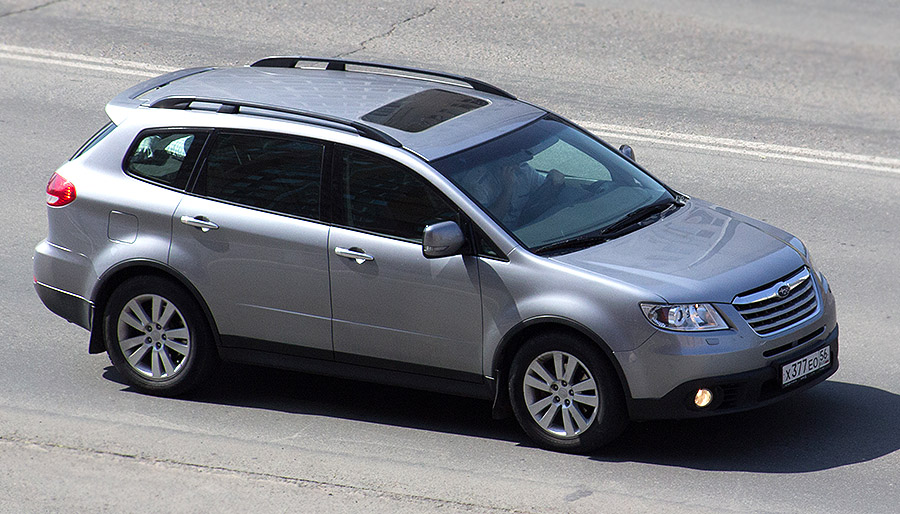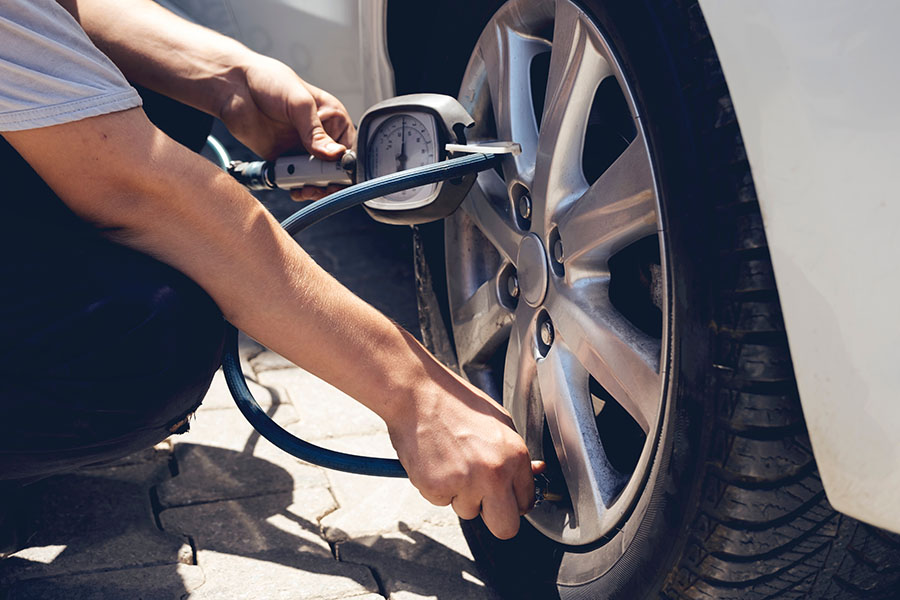Subaru Tribeca is equipped with Tire Pressure Monitoring System (TPMS) for the purpose of warning the driver when one or more of the tires are significantly under-inflated, creating a potentially unsafe driving condition. In this article we discuss the reasons for the amber colored TPMS warning light in Tribeca, and how you can reset it.

The TPMS warning light illuminates in Subaru Tribeca when air pressure is low in one or more of the tires, battery has depleted in a pressure sensor, TPMS receiver module has malfunctioned, or a pressure sensor has been damaged.
Low tire pressure
When the amber colored TPMS warning light  turns on in your Tribeca, stop your vehicle when it is safe to do so and check tire pressure on all the wheels, including the spare wheel (if your vehicle has one). Driving on a significantly under-inflated tire causes the tire to overheat and can lead to tire failure.
turns on in your Tribeca, stop your vehicle when it is safe to do so and check tire pressure on all the wheels, including the spare wheel (if your vehicle has one). Driving on a significantly under-inflated tire causes the tire to overheat and can lead to tire failure.

Reinflate the tires
Reinflate all the tires of your Tribeca to the manufacturer specified air pressure, which is mentioned on the vehicle placard or tire inflation pressure label usually located on the B-pillar or the edge of the driver door. If you can’t find the label, check the size of your tire which is mentioned on the sidewall of the tire, and match it to the tire pressure information shown below. These are official cold tire pressure values for Tribeca from Subaru.
- P255/55R18 104H: Front: 33 psi, Rear: 32 psi
- 255/55R18 105H: Front: 33 psi, Rear: 32 psi
- T165/80R17: 60 psi

Resetting the TPMS warning light
After you have inflated all the tires to the correct air pressure, the TPMS warning light will turn off automatically. Subaru Tribeca uses the direct method for monitoring tire pressure, which means a pressure sensor actively records the internal pressure and air temperature of the tire on each wheel. There is no need to reinitialize the TPMS system in order to reset the warning light. There is no reset button like the one you see in vehicles with indirect TPMS system which uses ABS sensors to detect low tire pressure.
If the low tire pressure light does not turn off automatically after reinflating the tires in your Tribeca, increase the tire pressure by 5 psi on top of the factory recommended value, and drive your vehicle for at least 10 miles (16 km). After the TPMS warning light turns off, and the vehicle has been parked for a few hours, reduce the tire pressure to the factory recommended value.
Chilly weather can turn on low tire pressure light in Tribeca
Cold weather is one of the most common cause for low tire pressure warning light in Subaru Tribeca. When analyzing WheelsJoint’s statistical data, it has been observed that there is sharp rise in the number of searches for TPMS warning light causes at the start of every winter season, about three times higher as compared to mid summer season.

The air, like most other substances, expands when heated and contracts when cooled. So when the weather gets colder, the tire pressure decreases, which could trigger TPMS warning light in Tribeca. The tire pressure will vary with temperature by about 1 psi (7 kPa) for every 12°F (6.5°C).

Inflate tires when cold
Tire pressure in Tribeca should always be set based on cold inflation tire pressure. This is defined as the tire pressure after the vehicle has not been driven for at least three hours, or driven less than 1 mile (1.6 km) after a three-hour period.
Do not adjust tire pressure when hot
The tires on your Tribeca can get around 50 degrees hotter than the outside temperature when you’re driving, which increases the tire pressure by about 4 psi – this is normal and there should be no adjustment for this increased pressure.
Does altitude affect tire pressure?
Yes, altitude can change tire pressure values, but it is negligible and not a cause for concern. If you drive your Tribeca from sea level to Mount Evans Scenic Byway in Colorado which is the highest paved road in North America at the altitude of 14,130 feet (4,307 m), the tire pressure should theoretically increase by approximately 6 psi. But, the decrease in ambient temperature at higher elevation contracts the air in tires and compensates for any altitude pressure changes.
Is it safe to drive Tribeca with low tire pressure?
The driving characteristics of Tribeca change even if the air pressure is 5 psi less than manufacturer’s recommended value: the braking distance can be longer, cornering worse, and at particularly high speeds there is even a risk that the tire will burst. Low tire pressure also increases tire wear, and the higher rolling resistance of the tire means higher fuel consumption. So it is recommended to reinflate the tires to the correct pressure as soon as possible.
Dead battery in a tire pressure sensor
Each tire pressure sensor in Tribeca is powered by a built-in lithium-ion battery. When the battery is depleted, the sensor stops transmitting tire pressure information to the receiver module. When this happens, the TPMS warning light will flash every time the engine is started, and will remain illuminated until you turn off the vehicle.

How long do the pressure sensor batteries last?
The tire pressure sensor batteries usually last anywhere from 5 to 10 years in Tribeca. When the battery is depleted, you must replace the sensor itself, as the battery is sealed into the sensor unit and is non-replaceable.
Identifying a faulty pressure sensor
The most reliable method for detecting a faulty tire pressure sensor or a sensor with dead battery is by testing each sensor with a scan tool. For example, MaxiTPMS TS408 is commonly used for diagnosing and programming tire pressure sensors. A sensor that is not detectable by the scanner is most likely defective and should be replaced with a new one.

If you don’t want to spend over a hundred bucks on a scanner, then head over to any reputable tire shop and perform a TPMS diagnostic scan of your Tribeca. Some shops like Discount Tire and Pep Boys offer free of charge TPMS diagnostic services.
Installed new tires?
If a pressure sensor stopped responding after you installed new tires on your Tribeca, it is possible the sensor got damaged during tire installation. These sensors are quite sensitive, and can be easily damaged if utmost care is not taken while changing tires.
Subaru Tribeca TPMS user guide
The tire pressure monitoring system provides the driver with a warning message by sending a signal from a sensor that is installed in each wheel when tire pressure is severely low.
The tire pressure monitoring system will activate only when the vehicle is driven at speeds above 20 mph (32 km/h). Also, this system may not react immediately to a sudden drop in tire pressure (for example, a blow-out caused by running over a sharp object).
If the low tire pressure warning light illuminates while driving, never brake suddenly. Instead, perform the following procedure. Otherwise an accident involving serious vehicle damage and serious personal injury could occur.
- Keep driving straight ahead while gradually reducing speed.
- Slowly pull off the road to a safe place.
- Check the pressure for all four tires and adjust the pressure to the COLD tire pressure shown on the vehicle placard on the door pillar on the driver’s side.
Even when the vehicle is driven a very short distance, the tires get warm and their pressures increase accordingly. Be sure to let the tires cool thoroughly before adjusting their pressures to the standard values shown on the tire inflation pressure label. The tire pressure monitoring system does not function when the vehicle is stationary. After adjusting the tire pressures, increase the vehicle speed to at least 20 mph (32 km/h) to start the TPMS rechecking of the tire inflation pressures. If the tire pressures are now above the severe low pressure threshold, the low tire pressure warning light should turn off a few minutes later.
If this light still illuminates while driving after adjusting the tire pressure, a tire may have significant damage and a fast leak that causes the tire to lose air rapidly. If you have a flat tire, replace it with a spare tire as soon as possible.
When a spare tire is mounted or a wheel rim is replaced without the original pressure sensor/transmitter being transferred, the low tire pressure warning light will illuminate steadily after blinking for approximately one minute. This indicates the TPMS is unable to monitor all four road wheels. Contact your SUBARU dealer as soon as possible for tire and sensor replacement and/or system resetting.
When a tire is repaired with liquid sealant, the tire pressure warning valve and transmitter may not operate properly. If a liquid sealant is used, contact your nearest SUBARU dealer or other qualified service shop as soon as possible. Make sure to replace the tire pressure warning valve and transmitter when replacing the tire. You may reuse the wheel if there is no damage to it and if the sealant residue is properly cleaned off. Do not inject any tire liquid or aerosol tire sealant into the tires, as this may cause a malfunction of the tire pressure sensors. If the light illuminates steadily after blinking for approximately one minute, promptly contact a SUBARU dealer to have the system inspected.
Caution: Do not place metal film or any metal parts under the driver’s seat. This may cause poor reception of the signals from the tire pressure sensors, and the tire pressure monitoring system will not function properly
If you adjust the tire pressures in a warm garage and will then drive the vehicle in cold outside air, the resulting drop in tire pressures may cause the low tire pressure warning light to illuminate. To avoid this problem when adjusting the tire pressures in a warm garage, inflate the tires to pressures higher than those shown on the tire placard. Specifically, inflate them by an extra 1 psi (6.9 kPa, 0.07 kgf/cm2) for every difference of 108F (5.68C) between the temperature in the garage and the temperature outside. By way of example, the following table shows the required tire pressures that correspond to various outside temperatures when the temperature in the garage is 608F (15.68C).
If the low tire pressure warning light illuminates when you drive the vehicle in cold outside air after adjusting the tire pressures in a warm garage, re-adjust the tire pressures using the method described above. Then, increase the vehicle speed to at least 20 mph (32 km/h) and check to see that the low tire pressure warning light turns off a few minutes later. If the low tire pressure warning light does not turn off, the tire pressure monitoring system may not be functioning normally. In this event, go to a SUBARU dealer to have the system inspected as soon as possible.
While the vehicle is driven, friction between tires and the road surface causes the tires to warm up. After illumination of the low tire pressure warning light, any increase in the tire pressures caused by an increase in the outside air temperature or by an increase in the temperature in the tires can cause the low tire pressure warning light to turn off.
System resetting is necessary when the wheels are changed (for example, a switch to snow tires) and new TPMS valves are installed on the newly fitted wheels. Have this work performed by a SUBARU dealer following wheel replacement.
It may not be possible to install TPMS valves on certain wheels that are on the market. Therefore, if you change the wheels (for example, a switch to snow tires), use wheels that have the same part number as the standard-equipment wheels. Without four operational TPMS valve/sensors on the wheels, the TPMS will not fully function and the warning light on the combination meter will illuminate steadily after blinking for approximately 1 minute.
When a tire is replaced, adjustments are necessary to ensure continued normal operation of the tire pressure monitoring system. Therefore, as with wheel replacement, you should have the work performed by a SUBARU dealer.
Reset the entire system
If the low tire pressure warning light won’t turn off due to a glitch in the tire pressure monitoring system, it may be possible to reset the TPMS system by resetting all on-board computers in your Tribeca. This method should only be considered as a last resort, when all else fails.

You can reboot all the on-board computers by disconnecting the main 12 volt battery for a few minutes. Remove the cable from the negative terminal of the battery first, then from the positive terminal. With the battery disconnected, press the horn button a few times and turn on the headlights to drain out all the residual electricity from the system. After about 15 minutes, reconnect the battery in reverse order: positive cable first, then negative cable.
Tire pressure keeps getting low
If the TPMS warning light turns on frequently in your Tribeca, and the tire pressure is also decreasing after you have reinflated the tires, there may be an air leak. One or more of the tires may have been punctured by an external object, or the air may be leaking from a defective value stem.

Can I disable the TPMS system in Tribeca?
No, the TPMS system is federally mandated, and cannot be disabled in Subaru Tribeca. All vehicles must have a working tire pressure monitoring system to be legally compliant.
Use OBD2 scanner for diagnosis
Since Subaru Tribeca is equipped with on-board diagnostics (OBD), a fault diagnosis can provide initial indications of where the malfunction is located. But when it comes to TPMS, a basic code reader will not suffice. You will need an advanced scanner to monitor TPMS data or read TPMS codes.

BlueDriver is a commonly used scanner by DIYers that can read TPMS codes for most vehicles and isn’t too expensive – costs about a hundred bucks. You can also clear the TPMS fault codes with this device which will turn off the warning light, but the light may come back on if the on-board diagnostic system detects a fault again.



